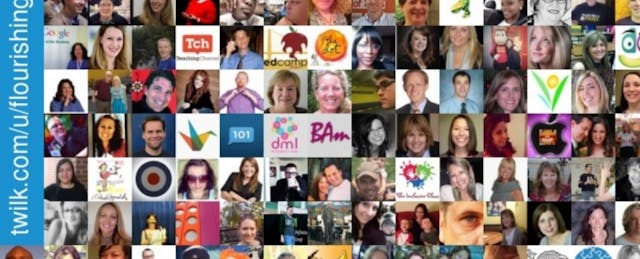Being connected is not easy. I’ve spent three years on Twitter building relationships and co-moderating and participating in education chats. I am constantly reading (and writing!) blogs; all this in the pursuit of being a better teacher. Although the time it takes to develop a network is substantial, the benefits of connection far outweigh the efforts.
Here are seven ways that my students benefit from the online Professional Learning Network I have built over the years:
1) New ways to solve problems. My students benefit by having a wide range of tools like iPad apps with math manipulatives such as Teaching Table, or apps like Educreations that allow them to create screen-casts. By participating in chats and talking to peers on Twitter, I discover an incredible array of tools that allow my students to learn and demonstrate learning in a multitude of ways: blogging, screen-casting, and even writing songs.
2) I learn from the collective wisdom of the crowd. We promote the idea that students should develop skills by observing others as they learn and make mistakes. Surely it makes sense for us to connect and learn vicariously through the lives and work of other teachers. If another teacher has used a process or tool and has shared what worked or didn’t work, this can save enormous time and energy. My students then have a teacher who is not as exhausted, but continuously inspired by stories of “what really works.”
3) A growth mindset. Being a connected educator brings with it many opportunities to grow. As a somewhat shy person, it takes a lot for me to present at conferences. But my online connections have led to invitations to present at national conferences like SXSWedu and global online conferences such as The Reform Symposium. My students benefit in several ways, one of which is by seeing me taking risks. I share my stories of the process of preparing for these conferences and also the feeling of not initially wanting to take on such challenges. My students gain the courage to tackle new experiences and know that I feel their pain!
4) My students impact the world through collaborative projects and global connections. Through Twitter, I have talked with authors and experts from around the world. My students know that I don’t have to be the expert on everything because I can reach out and invite others into our classroom through Skype. They gain a broader perspective and deeper appreciation for diverse viewpoints and can envision more career options for their own future. I have actually heard students verbalize new possibilities for their futures after meeting online with scientists and authors.
Last year, my students participated in a Global Read Aloud Project and shared insights and thinking with students in Argentina, Australia and many other states. During Skype calls to talk about the book, The One and Only Ivan, students realized that they had more in common than they had ever imagined, like enjoying similar opinions about the characters and discovering that they even shared common recess games. When a class of 24 students in Argentina had to cram into a tiny principal’s office so that they could connect during a rainstorm, my students were impressed by the tenacity and gained compassion for the hardships of others.
5) My students learn from entrepreneurs and see themselves as critical reviewers of educational technology. My students have met innovative teams from Motion Math, Toontastic and Kaizena physically, face to face and learned the power of giving critical feedback! They have beta-tested products, participated in studies, and most importantly, learned how to offer thoughtful and critical feedback. We want students to be able to develop critical thinking skills and discover the power of their individual voices, right? After these experiences, I have been thrilled to hear that my students have signed up for courses to learn coding or have begun to “invent” things on the weekend. The entrepreneurial spirit begins in these key moments.
6) Students receive inspirational feedback on their work! Through blogging, my students have received encouragement and inspiration from their families, as well as other educators and authors in my network. Students who are somewhat reluctant in writing often have a new spark when they realize that the audience is global and that someone “famous” might comment! Last year, one of my shyest, quietest students gained a new respect in class after author Peter H. Reynolds commented on her blog post. In June, 2013 I was fortunate to meet Peter and thank him for his impact on my student. Here is the conversation that followed.

7) I keep perspective and avoid burnout. One of the saddest aspects of our profession is the possibility of burnout. With my wonderful PLN, I can share tales of a tough day, vent, and brainstorm ways to move forward. Sometimes it just isn’t possible to do that with the teacher next door. I view my network as a wise collective who will challenge my thinking. Here is a short video where I share the “Gift of Being Connected.”
If you’re not yet connected, please reach out and ask questions, start conversations. We are richer and wiser through our relationships with others. A powerful teacher inspires powerful students who know how to think and to question. And that power comes from the collective wisdom of your network. This is a hard job, and it only gets better when we connect.


